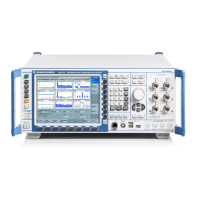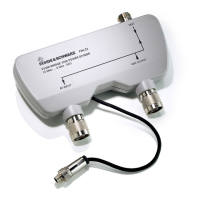Basic Instrument Functions
R&S
®
CMW500
111User Manual 1173.9463.02 ─ 02
Ext. Time Delay / Ext. Sample Delay
Inform the instrument about the delays in the individual external I/Q paths. For each I/Q
connector you can enter the delay either in time units or in samples. Relevant delays can
be caused by instruments or devices inserted into the external path, e.g. an R&S EX-IQ-
BOX or an R&S SMU200A.
The entered delay is e.g. used to correct measured round-trip times, the timing of trigger
events or the time relation between downlink and uplink signals.
For background information on the digital I/Q board and many possible test setups
(including fading tests) refer to the user manual "R&S CMW500 Protocol Testing – Test
Setups and Use Cases" (stock no. 1202.3840.12).
SCPI command:
n/a
5.4 Instrument Setup Dialog
The "Instrument Setup" dialog is only relevant for instruments with several RX and TX
signal paths. These instruments are equipped with six RF connectors at the front panel,
while instruments with one path provide only three RF connectors.
The dialog allows to split the instrument into two sub-instruments which operate inde-
pendently. Each sub-instrument is addressed separately and equipped with independent
hardware and software resources in order to run the tasks assigned to it.
See also Sub-Instruments.
To open the dialog press DEVICE.
Fig. 5-18: Instrument Setup dialog
Select Type
Selects the number of sub-instruments. The physical instrument can be split into two sub-
instruments or all resources can be assigned to a single (sub-)instrument.
Changing this setting also resets the Measurement Controller Dialog and Generator/Sig-
naling Controller Dialog so that the taskbar is cleared.
In the factory default configuration, all resources are grouped together in a single
(sub-)instrument. Splitting the instrument can help to run tasks in parallel, and minimize
the risk of resource conflicts between these tasks.
Instrument Setup Dialog

